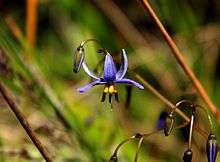Dianella revoluta
Dianella revoluta, the blueberry lily is a perennial herb of Australia.
| Dianella revoluta | |
|---|---|
 | |
| flowers, near the Great Ocean Road, Victoria, Australia | |
| Scientific classification | |
| Kingdom: | Plantae |
| Clade: | Tracheophytes |
| Clade: | Angiosperms |
| Clade: | Monocots |
| Order: | Asparagales |
| Family: | Asphodelaceae |
| Subfamily: | Hemerocallidoideae |
| Genus: | Dianella |
| Species: | D. revoluta |
| Binomial name | |
| Dianella revoluta R. Brown | |
Taxonomy
It was first described in 1810 by Robert Brown. Commonly known as the black-anther flax-lily, blueberry flax-lily or spreading flax-lily,[1]
Placed with the genus Dianella of the family Asphodelaceae, subfamily Hemerocallidoideae,[2] found across Australia and Tasmania.[3] so allied to twenty to forty other species.[4]
Revisions of Dianella revoluta have produced new taxonomic descriptions, as with species Dianella admixta. Several varieties have been described, those named in Western Australia are[5]
- Dianella revoluta var. divaricata (R.Br.) R.J.F.Hend, flax lily.[6]
- Dianella revoluta var. revoluta (Dianella revoluta R.Br. var. revoluta). The flowers are blue-violet.[7]
- Dianella revoluta var. brevicaulis was later named as Dianella brevicaulis (Ostenf.) G.W.Carr & P.F.Horsfall [8]
Description
Dianella revoluta flowers in spring with a star-like purple flower which develops into a blue to purple berry.[9] The berry fruit is reported to be edible.[10]
Cultural use
Dianella, Western Australia was named after this plant, which was plentiful in the area prior to the 1960s residential development.[11]
References
- "Dianella revoluta". Australian Plant Name Index (APNI), IBIS database. Centre for Plant Biodiversity Research, Australian Government.
- Stevens, P.F. (2001 onwards), "Hemerocallidoideae", Angiosperm Phylogeny Website, retrieved 2016-06-10
- H. Trevor Clifford, Rodney J.F. Henderson, and John G. Conran. 1998. "Hemerocallidaceae" pages 245-253. In: Klaus Kubitzki (editor). 1998. The Families and Genera of Vascular Plants volume III. Springer-Verlag: Berlin;Heidelberg, Germany. ISBN 978-3-540-64060-8
- Search for "Dianella", World Checklist of Selected Plant Families, Royal Botanic Gardens, Kew, retrieved 4 September 2014
- "Search "Dianella"". FloraBase.
- "Dianella revoluta". FloraBase. Western Australian Government Department of Parks and Wildlife.The flowers are blue-purple
- "Dianella revoluta". FloraBase. Western Australian Government Department of Parks and Wildlife.
- "Dianella revoluta". FloraBase. Western Australian Government Department of Parks and Wildlife.
- Anthony Huxley, Mark Griffiths, and Margot Levy (1992). The New Royal Horticultural Society Dictionary of Gardening. The Macmillan Press, Limited: London. The Stockton Press: New York. ISBN 978-0-333-47494-5 (set).
- Wild food plants of Australia, Tim Low
- "Perth suburb names". Landgate. Government of Western Australia. Retrieved 17 October 2017.